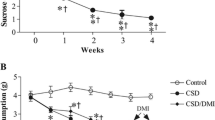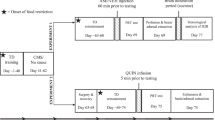Abstract
Chronic exposure to mild unpredictable stress has previously been found to depress the consumption of a palatable (1%) sucrose solution, and to attenuate food-induced place preference conditioning. In this study the effects of pramipexole (SND-919), a dopamine D2 agonist, were studied during 7–9 weeks of chronic treatment. Pramipexole (1.0 mg/kg per day) reversed the suppression of sucrose intake in stressed animals, increasing sucrose intakes above the levels seen in untreated nonstressed controls. Pramipexole also increased sucrose intake in nonstressed animals; these effects were accompanied by increases in water intake and tended to correlate with weight loss. Drug-treated stressed animals also lost weight, but in this case water intake was unaffected. A second group of animals received a higher dose of pramipexole (2.0 mg/kg per day). The effects of the two doses were very similar. After three weeks of treatment, these animals were switched to a lower dose of pramipexole (0.1 mg/kg per day). Increases in sucrose intake were maintained over three weeks of treatment at the lower dose, with significant recovery of body weight. Two further groups received the same doses of pramipexole (1.0 mg/kg for 6 weeks or 2.0 mg/kg for 3 weeks followed by 0.1 mg/kg thereafter), but received intermittent (twice-weekly) drug treatment. Intermittent pramipexole treatments also tended to increase sucrose intakes, but the results were less consistent from week to week. Following 6–8 weeks of pramipexole treatment, food-induced place preference conditioning was studied in all animals. Untreated stressed animals showed no evidence of place conditioning. Normal conditioning was seen in both groups of stressed animals treated daily with pramipexole (at 1.0 and 0.1 mg/kg) and in the group treated twice weekly at the higher dose (1.0 mg/kg); intermittent treatment at the lower dose (0.1 mg/kg) was ineffective. The results indicate that pramipexole exerts rapid anti-anhedonic effects in the chronic mild stress model. This conclusion is complicated, but not undermined, by drug-induced weight loss and by the presence of significant drug effects in nonstressed control animals.
Similar content being viewed by others
References
Ayd FJ, Zohar J (1987) Psychostimulant (amphetamine or methylphenidate) therapy for chronic and treatment-resistant depression. In: Zohar J, Belmaker RH (eds) Treating resistant depression. PMA Publishing Corp., New York, pp 343–355
Bozarth MA (1987) Conditioned place preference: a parametric analysis using systemic heroin injections. In: Bozarth MA (ed) Methods of assessing the reinforcing properties of abused drugs. Springer, Heidelberg, pp 241–273
Cheeta S, Broekkamp CLE, Willner P (1994) Stereospecific reversal of stress-induced anhedonia by mianserin and its (+)-enantiomer. Psychopharmacology, in press
Delina-Stula A, Radeke E, Van Riezen H (1988) Enhanced functional responsiveness of the dopaminergic system: The mechanism of anti-immobility effects of antidepressants in the behavioural despair test in the rat. Neuropharmacology 27:943–947
Fawcett J, Clark DC, Scheftner WA, Gibbons RD (1983) Assessing anhedonia in psychiatric patients: The pleasure scale. Arch Gen Psychiatry 40:79–84
Klein DF (1974) Endogenomorphic depression: a conceptual and terminological revision Arch Gen Psychiatry 31:447–454
Klimek V, Maj J (1989) Repeated administration of antidepressant drugs enhanced agonist affinity for mesolimbic D-2 receptors. J Pharm Pharmacol 41:555–558
Maj J (1988) Repeated treatment with antidepressant drugs and functional changes of catecholaminergic receptors at the behavioural level. In: Belmaker RH, Sandler M, Dahlstrom A (eds) Progress in catecholamine research: part C, clinical aspects. Liss, New York, pp 255–261
Mierau J, Schingnitz G (1992) Biochemical and pharmacological studies on pramipexole, a potent and selective dopamine D2 receptor agonist. Eur J Pharmacol 215:161–170
Moreau J-L, Jenck F, Martin JR, Mortas P, Haefely WE (1992) Antidepressant treatment prevents chronic unpredictable mild stress-induced anhedonia as assessed by ventral tegmental self-stimulation behavior in rats. Eur Neuropsychopharmacol 2:43–49
Moreau J-L, Jenck F, Martin JR, Mortas P, Haefely WE (1993) Effects of moclobemide, a new generation reversible MAO-A inhibitor in a novel animal model of depression. Pharmacopsychiatry 26:30–33
Mouret J, LeMoine P, Minuit M (1987) Marqueurs polygraphiques, cliniques et therapeutiques des depressions dopamino-dependantes (DDD). Comptes Rend l'Academie de Science, Paris, 305 [Serie III]:301–306
Muscat R, Willner P (1992) Suppression of sucrose drinking by chronic mild unpredictable stress: a methodological analysis. Neurosci Biobehav Rev 16:507–517
Muscat R, Towell A, Willner P (1988) Changes in dopamine autoreceptor sensitivity in an animal model of depression. Psychopharmacology 94:545–550
Muscat R, Sampson D, Willner P (1990) Dopaminergic mechanism of imipramine action in an animal model of depression. Biol Psychiatry 28:223–230
Muscat R, Papp M, Willner P (1992a) Reversal of stress-induced anhedonia by the atypical antidepressants, fluoxetine and maprotiline. Psychopharmacology 109:433–438
Muscat R, Papp M, Willner P (1992b) Antidepressant-like actions of dopamine agonists in an animal model of depression. Biol Psychiatry 31:937–946
Papp M, Willner P (1991) 8-OH-DPAT-induced place preference and place aversion: effects of PCPA and dopamine antagonists. Psychopharmacology 103:99–102
Papp M, Willner P, Muscat R (1991) An animal model of anhedonia: attenuation of sucrose consumption and place preference conditioning by chronic unpredictable mild stress. Psychopharmacology 104:255–259
Papp M, Lappas S, Muscat R, Willner P (1992) Attenuation of place preference conditioning but not place aversion conditioning by chronic mild stress. J Psychopharmacol 6:352–356
Papp M, Muscat R, Willner P (1993a) Subsensitivity to rewarding and locomotor stimulant effects of a dopamine agonist following chronic mild stress. Psychopharmacology 110:152–158
Papp M, Muscat R, Willner P (1993b) Behavioural sensitization to a dopamine agonist is associated with recovery from stress-induced anhedonia. Psychopharmacology 110:159–164
Plaznik A, Kostowski W (1987) The effects of antidepressants and electroconvulsive shocks on the function of the mesolimbic dopamine system: a behavioural study. Eur J Pharmacol 135:389–396
Post RM, Gerner RH, Carman JS, Gillin JC, Jimerson DC, Goodwin FK, Bunney WE (1978) Effects of a dopamine agonist piribedil in depressed patients. Arch Gen Psychiatry 35:609–615
Reus VI, Lake CR, Post RM (1980) Effect of piribedil (ET-495) on plasma norepinephrine: Relationship to antidepressant response. Commun Psychopharmacol 4:207–213
Sampson D, Muscat R, Willner P (1991) Reversal of antidepressant action by dopamine antagonists in an animal model of depression. Psychopharmacology 104:491–495
Schneider CS, Mierau J (1987) Dopamine autoreceptor agonists: resolution and pharmacological activity of 2,6-diaminotetrahy-drobenzothiazole and an aminothiazole analogue of apomorphine. J Med Chem 30:494–498
Serra G, Collu M, D'Aquila PS, de Montis GM, Gessa G (1990) Possible role of dopamine D1 receptor in the behavioural subsensitivity to dopamine agonists induced by chronic treatment with antidepressants. Brain Res 527:234–243
Shopsin B, Gershon S (1978) Dopamine receptor stimulation in the treatment of depression: piribedil (ET-495) Neuropsychobiology 4:1–14
Stamford JA, Muscat R, O'Connor JJ, Patel JJ, Wieczorek WJ, Kruk ZL, Willner P (1991) Voltammetric evidence that subsensitivity to reward following chronic mild stress is associated with increased release of mesolimbic dopamine. Psychopharmacology 105:275–282
Theohar C, Fischer-Cornellson K, Akesson HO, Ansari J, Gerlach G, Ohman R, Ose E, Stegink AJ (1981) Bromocriptine as antidepressant: double-blind comparative study with imipramine in psychogenic and endogenous depression. Curr Ther Res 30:830–842
Van der Kooy D (1987) Place conditioning: a simple and effective method for assessing the motivational properties of drugs. In: Bozarth MA (ed) Methods of assessing the reinforcing properties of abused drugs. Springer, Heidelburg, pp 229–240
Waehrens J, Gerlach J (1981) Bromocriptine and imipramine in endogenous depression: a double-blind controlled trial in outpatients. J Affect Disord 3:193–202
Willner P, Towell A, Sampson D, Sophokleous S, Muscat R (1987) Reduction of sucrose preference by chronic mild stress and its restoration by a tricyclic antidepressant. Psychopharmacology 93:358–364
Willner P, Klimek V, Golembiowska K, Muscat R (1991a) Changes in mesolimbic dopamine may explain stress-induced anhedonia. Psychobiology 19:79–84
Willner P, Sampson D, Papp M, Phillips G, Muscat R (1991b) Animal models of anhedonia. In: Simon P, Soubrie P, Widlocher D (eds) Animal models of psychiatric disorders, vol 3. Karger, Basel, pp 71–99
Winer BJ (1971) Statistical principles in experimental design. McGraw Hill, London
Zacharko RM, Anisman H (1991) Stressor-provoked alterations of intracranial self-stimulation in the mesocortiolimbic dopamine system: an animal model of depression In: Willner P, Scheel-Kruger J (eds) The mesolimbic dopamine system, from motivation to Action. Wiley, Chichester, pp 411–442
Author information
Authors and Affiliations
Rights and permissions
About this article
Cite this article
Willner, P., Lappas, S., Cheeta, S. et al. Reversal of stress-induced anhedonia by the dopamine receptor agonist, pramipexole. Psychopharmacology 115, 454–462 (1994). https://doi.org/10.1007/BF02245568
Received:
Revised:
Issue Date:
DOI: https://doi.org/10.1007/BF02245568




